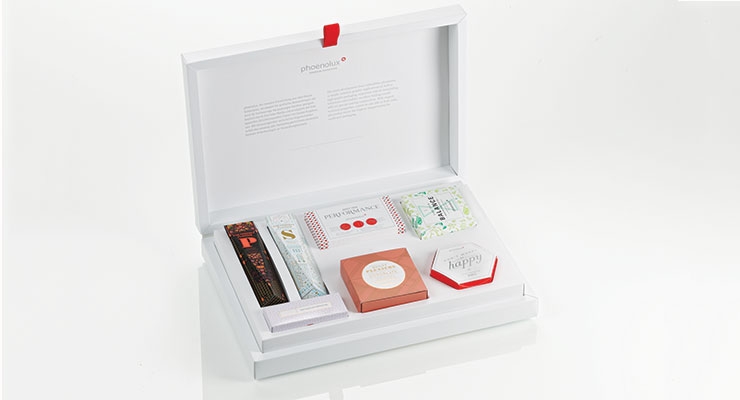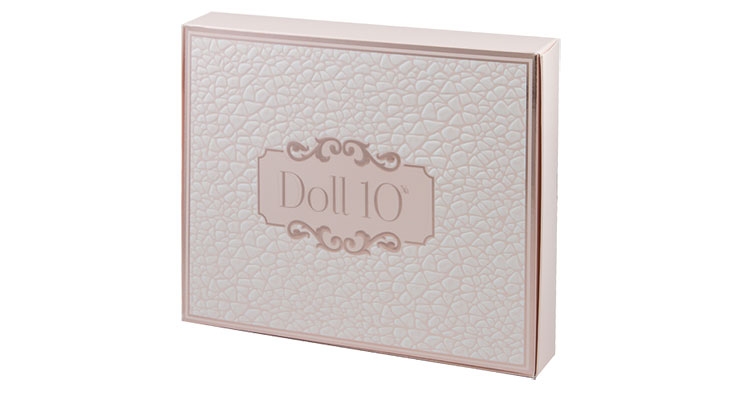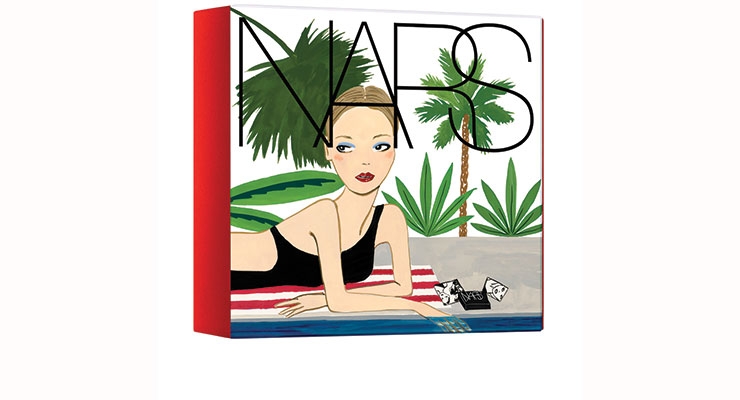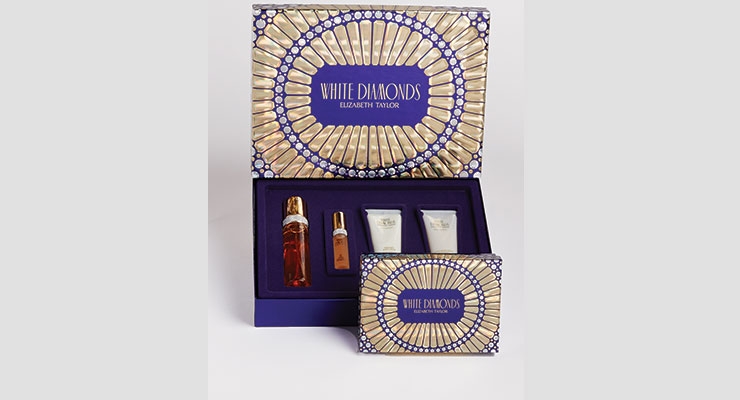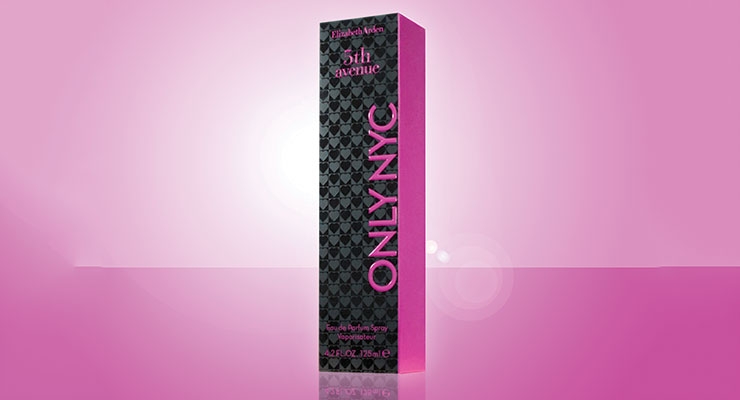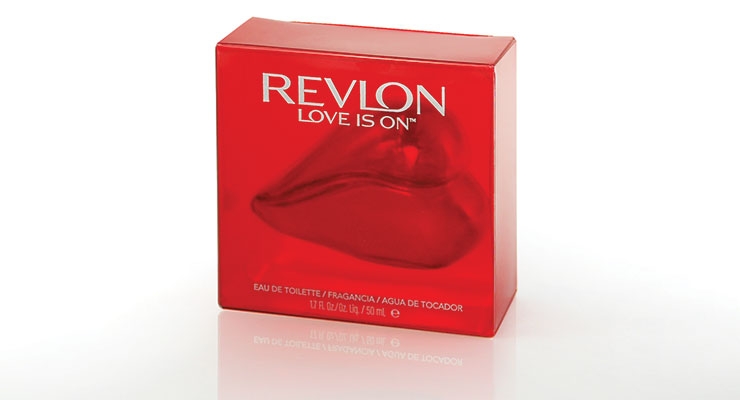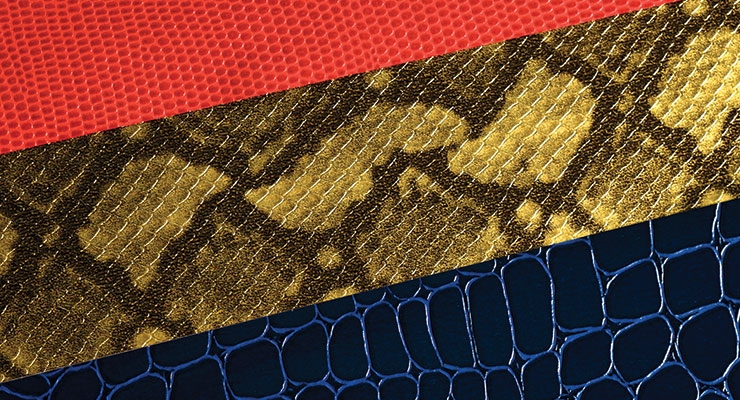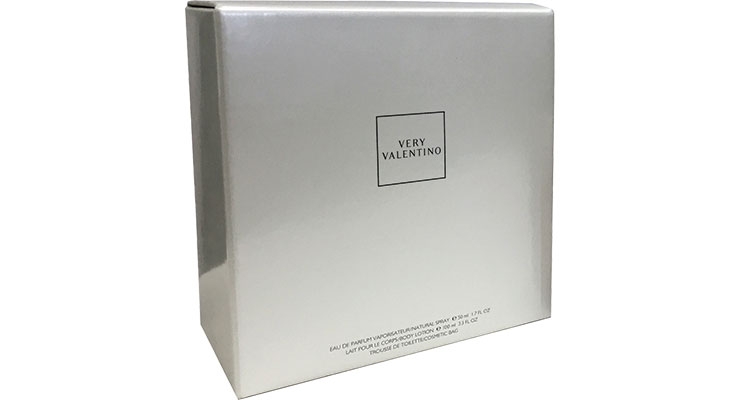Marie Redding, Associate Editor07.25.16
Beauty brands, including mass, prestige, and Indie, all strive to design folding cartons and boxes with one common goal in mind—to “wow” the consumer. Secondary packaging is usually the first part of a product that a consumer sees or touches, so it is a critical part of the “brand experience.”
“Secondary packaging shouldn’t be an afterthought,” says Earl Guinter, vice president, sales and marketing, Envision Packaging. He says that on occasion he will remind his customers that the carton is a marketing tool, not only a functional container. “We often collaborate with our customers to provide structural design ideas and innovative decorating solutions,” he says.
Pat McGee, vice president of marketing, HLP Klearfold, says that when a carton is well-executed visually and has eye-catching aesthetics, it helps to create the perception of added value for the consumer. “This has a proven track record of enhancing a brand’s performance at retail,” he says.
At Diamond Packaging, Dennis Bacchetta, director of marketing, says that when a carton is sitting on a store shelf, its job is to be a “brand ambassador.” “It has to succeed in making an impact by communicating a brand’s positioning, while inviting consumer interaction,” he explains.
Brands are doing much more with decoration, to give a carton or box a striking look, according to Joe Cicci, president, Color Optics, a division of Phoenix Color. “The new minimum number of colors has risen to eight or ten, so we have added more color options to our presses to accommodate requests,” he says.
Brands are also combining decorative effects in new ways, observes John Rebecchi, senior vice president, DISC. “Using two types of treatments, for example, was typical at one time. Now, combining several different types of decorating processes is the norm,” he says.
When deciding on a decorating process for a carton or creating a unique structural design for a box, all brands aim for one common goal—to make that first connection with the consumer. “Every brand strives to make sure that once a consumer picks up a box, they won’t put it down,” says Rebecchi.
Don’t Underestimate the Importance of the Box
It’s a mistake to assume that a carton or box is not as important as a product’s primary package, according to Doris Dalton, founder of Doll 10 Beauty. The brand sells mainly on QVC, where the secondary packaging is usually not even shown to viewers before they decide to make a purchase.
However, Dalton says the box matters—a lot. “There is such a tremendous amount of competition in the beauty industry, and customers ‘vote’ every single time they make a purchase. Every part of your packaging has to warrant that vote,” she remarks.
Dalton believes that every beauty brand must strive to ‘wow’ the customer, repeatedly. “When the customer receives a Doll 10 product in the mail, it needs to impress them even more than it did on QVC because now it is in their home. The outer packaging has to look and feel luxurious. The customer needs to feel like they are opening up something special when they are touching the carton or box,” she says.
Dalton explains that she likes to “check a couple of boxes” when she is working with suppliers to develop a design for a new carton. She says she asks herself two questions: “Does it have visual appeal?” And, “does it feel sensual, or inviting, to touch?” She says, “It takes both elements, and the graphics team at DISC always helps fulfill our wish list. They will take my conceptual idea and make sure the design conveys that message.”
DISC produces the majority of Doll 10’s cartons. “Our holiday cartons this year will be amazing,” she says, hinting that they will be decorated with the image of a vanity mirror, created with shiny foil. “There is also text printed in the mirror, and lots of other design elements that truly help make it something special,” she says.
Special Looks for Limited Editions & Gifts
Boxes and cartons will usually feature special designs and eye-catching decorative effects when used for a promotional item, limited edition collection or a holiday gift set. A brand might opt for a look that is completely unexpected to surprise the consumer, drawing attention to the new launch.
NARS Cosmetics launched its limited edition summer 2016 cosmetics collection in cartons that look completely different from the brand’s signature soft-touch black. They are decorated with colorful illustrations of stylish women in summer scenes, vacationing on the French Riviera, complete with pools and palm trees.
The hand-painted illustrations are by contemporary artist Konstantin Kakanias. NARS recruited Kakanias due to his extensive work in fashion, including designing textiles for Yves Saint Laurent and Christian Lacroix. His illustrations have also been featured in numerous publications, including Italian and French Vogue.
The bold colors on the cartons reflect the saturated pigments in the makeup line, which includes Lip Covers, in rich hues such as vivid orange-red; plus Dual-Intensity Eyeshadows, in sheer and glistening shades such as teal-green and seashell pink.
By summer, most suppliers are finishing up projects for the upcoming holiday season, which usually includes all types of set-up boxes for gift sets, and even luxury brands will choose over-the-top decorations to turn a typical folding carton into a “glitzy” gift.
“More glitter” is what some suppliers say they have been hearing a lot lately from prestige brands, especially for upcoming holiday launches. “A glitter effect is typically silk-screened, which is an off-line process that will typically increase costs. Our Opti-Glitter technique is an economical way to achieve a glitter effect without silk-screening. It looks very similar, and its affordability makes it possible for more brands to utilize this type of decoration,” says Color Optics by Arcade's Cicci.
Color Optics by Arcade used a combination of various decorative effects to produce the gift set box for Elizabeth Arden’s fragrance set, White Diamonds by Elizabeth Taylor. “We produced a design for the set box wrap that incorporates multiple decorating processes. It required multi-passes using metallized polyester paper, holographic stamping and registered embossing,” Cicci explains.
Combining these various techniques on the press to produce the desired result required some effort. “Without giving away all our trade secrets, we combined various holograms with each pass, which required fine registration. It was a challenging process to develop, and we were able to achieve a unique look,” Cicci says. “This box recently won an NJPEC Award, as well as many others,” he adds.
Color Optics recently announced its merger with Phoenix Color. “Combining the capabilities of both companies, along with the announced capital investments, will provide excellent opportunities for our customers,” says Cicci.
Another option for gift set packaging is Diamond Packaging’s trademarked design called QuickSet. “It is an economical alternative to a rigid set-up box, with a reinforced base and lid. It allows for direct application of graphics, stamping, or embossing, and ships flat,” says Bacchetta.
Combining Color & Texture To Attract Consumers
Brilliant decorations designed to attract the consumer’s eye aren’t only for gift sets or limited edition launches. Suppliers say that color is being used in more creative ways, especially when combined with various textural effects. Brands are working with suppliers to utilize many of the newest printing technologies and decorative effects for cartons—to “wow” the consumer with each new launch.
However, Michele Squicciarini, senior sales director, Jansy Packaging, says she is seeing the opposite trend: Many of her prestige customers are asking about ways to use less color, especially for fragrance cartons. She explains, “We have been fulfilling requests for cartons and boxes that have monotone and simplistic looks. We are also seeing more brands choose black and white more often than vibrant colors, and this is when choosing the right materials is critical for a high-end look.”
Less color means that decorative textures become more important. Solid black suddenly becomes ‘sexy’ when it has a soft touch finish, while solid white might go from “basic” to “interesting” when it is decorated with ribbing or an embossed honeycomb pattern.
“Texture is so important, especially this year,” says Squicciarini. “We are hearing lots of requests for embossing and using new types of textures,” she says.
Diamond Packaging’s Bacchetta says that his customers are requesting more color. “We also hear many requests to combine visual and tactile elements, such as using multiple coatings in both matte and gloss finishes. These looks will often entice the consumer to interact with a package—picking it up to inspect it more closely.”
Diamond Packaging recently produced a black and hot pink carton for the fragrance 5th Avenue Only NYC by Elizabeth Arden, and says it is an example of how to use color and texture to make sure a design “pops.”
“This carton is “a strikingly visual and tactile presentation that stands out in the retail environment and conveys the essence of the luxury brand,” explains Bacchetta. He says, “It beautifully complements the design of the primary container—a glass bottle with tall clean lines, purple color palette and gold infused cap.”
The carton features a repeating black heart pattern, decorated with a matte and spot UV gloss.
“The front panels feature high gloss embossed accents that complement the interlaced matte and spot UV gloss pattern surrounding it. Our DiamondTouch soft touch coating adds an appealing tactile quality that promotes consumer interaction,” Bacchetta says.
The carton was converted using metallized polyester board, printed with UV flexo fuchsia purple, dense black, and opaque white offset inks. “The brilliance of the mirror-like finish of the metallized polyester film makes it a perfect choice for conveying stunning graphics,” Bacchetta adds.
Bacchetta also mentions a study that proves using a foil decoration will attract the consumers’ eye. “Packaging decorated with foil ranks more than 80% higher than non-foil packaging, in conveying quality, appeal, value and brand awareness,” he says, citing a study done by the Foil & Specialty Effects Association in 2014. A few of the flashy decorative effects Diamond Packaging offers are Liquid Metal, metallic UV coatings, and Cast and Cure holographic effects.
Color Optics’ Cicci is a fan of cold foiling. He comments, “Now that cold foil technology is available, it is a cost-effective way to ensure a carton stands out at retail.”
DISC’s Rebecchi also mentions the benefits of this process, saying, “Cold foiling techniques now allow us to create designs that feature very fine details. This was extremely challenging to do years ago if you had to use hot-stamping.” DISC offers several foil options for a cold foil process, including a variety of rainbow holographic patterns.
DISC employs a technical team that works closely with its customers to help decide on the right decoration to execute a design. “We like to say we take a consultative approach to every project,” Rebecchi says.
Curtis Packaging offers an alternative to cold foil called CurtChrome. “This decoration delivers a printable silver surface that often exceeds our customers’ expectations,” says Mike Simko, vice president of sales, Curtis Packaging.
The supplier developed this metallic ink decorating process more than 10 years ago, but continually improves the ink mixture to keep costs low and compete with the price of cold foiling. “We use our flexo units to apply a high metallic silver ink to the substrate. This ink has foil-like properties, and we can print any color directly on top, with perfect registration, without the jagged lines that can occur when using cold foil,” Simko explains.
Curtis Packaging also offers three new proprietary coatings for cartons and boxes. CurtMotion is a coating that creates a lenticular look. “It appears to be moving, while also delivering a textural effect,” Simko says.
The supplier’s Line Grit Coating creates a rough, textured surface when applied to a carton or box. “We can add a sparkle-like effect to this coating,” says Simko. Curtis Packaging’s Coatography coating replicates the look and feel of embossing. “We can create any pattern that you imagine,” Simko adds.
Choosing the Perfect Paper for Decoration
A decoration or decorative effect won’t look its best unless it is combined with the right substrate, since certain types of printed graphics and textural effects work best with specific types of paperboard. Suppliers often collaborate with brands, considering different weights, colors and finishes, to choose the best materials to convey the look that a package designer has in mind.
DISC’s Rebecchi says that he is seeing a demand for cartons that look more high-end, no matter where the product is sold. “One way to do this is to upgrade to bright white paper stock, and use speciality finishes,” he says.
Papierfabrik Scheufelen, based in Germany, offers a premium coated board called phoenolux that is now available in more options. “We continue to widen the available caliper range for phoenolux,” says Leif Dahlberg, vice president of sales, North America, Papierfabrik Scheufelen.
Dahlberg explains, “Our C1S product line now starts with 7pt board, specially designed for certain applications that include lamination on solid board or micro flute. It offers a smoothness, firmness and brightness that are advantages over using a typical litho paper. These qualities make it possible to emboss deeper, while maintaining more detail. A converter will also be able to achieve sharp corners without using a chipboard mitering process first.”
Papierfabrik Scheufelen’s new highest grades of C1S are 18pt and 19pt., which are ideal for gift set boxes. “Our C2S product line consists of 6 grades from 10pt to 18pt, and we are working on reaching 20pt soon. The positive feedback we have heard from printers about the ‘runnability’ and convertibility of phoenolux ensures brand owners that it delivers perfect folding and finishing results,” he adds.
Neenah Packaging offers a new collection of box wrap papers, which include premium and luxury collections, with an extensive library of metal-like finishes, plush textures, fine leathers and exotic skins.
Neenah Packaging’s PELLAQ Papers feature embossings that look like animal skins, and the collection includes everything from crocodile and iguana to snakeskin. “They are fully customizable; select a color, then choose an embossed texture,” explains Mark Sng, director of marketing, Neenah Packaging. “It will enhance the visual appeal and deliver that ‘touch’ factor,” he adds.
“Our Premium Box Wrap papers lend well to offset printing, while the luxury collection of tactile papers offers a level of durability and performance that is necessary to execute decorating techniques that include foil stamping, embossing, debossing, and burnishing,” says Sng.
Plastic Cartons Deliver a ‘Big Reveal’
A plastic carton often allows a beauty brand to show the product to consumers through a clear or semi-clear side, and this may influence a purchase. “Plastic cartons showcase products beautifully and allow consumers to see exactly what they’re getting. A direct view of the product or primary package in a clear plastic folding carton is much more impactful than a printed image on paperboard,” says Pat McGee, vice president of marketing, HLP Klearfold.
Decorating techniques for plastic cartons are similar to the processes offered for paperboard. Envision Packaging offers a SoftTouch decorating process for a velvety finish; ShimmerPrint, for a glitter effect; and Chrome Technology, which enhances 4-color printing and uses silver foil as a backing.
Sometimes, however, graphics that will “pop” on a folding carton made from paperboard will look flat and ordinary on plastic. Envision’s Guinter suggests decorating a plastic carton with an area that is clear, contrasted by surrounding areas that feature a printed design. “This will highlight the product inside. When combined with the right decoration, a plastic carton will distinguish a brand on the shelf and stand out among a sea of me-too paperboard packages,” he says.
McGee also advises taking advantage of certain design techniques on plastic to maximize visual impact, and also points out that contrasting elements work best. “The most engaging plastic folding cartons are designed to take full advantage of the transparent substrate. Carton graphics that combine transparent areas that are left unprinted, with translucent areas, see-through color, and opaque printed areas are the most interesting,” he explains. “This type of design will give a plastic carton a three-dimensionality that will have the greatest aesthetic appeal,” he says.
HLP Klearfold has a new 13-color, combination printing press with a gravure station that offers numerous decorating options. “Our new press also has 12 web-flexo stations, up to five of which can be configured for backside printing, or swapped out with up to four rotary silkscreen and two cold foil unit stations,” says McGee. “It delivers exceptional print quality with bold, vibrant colors, in a single pass. Achieving similar results using traditional UV offset printing, off-line silkscreen printing and foil stamping would require five or more passes,” he says.
HLP Klearfold worked with Revlon last fall to produce a transparent red plastic carton for its Love Is On fragrance. “It contains a clear APET vac-tray that positions the heart-shaped bottle inside to look as if it is floating, giving it a distinctive look,” says McGee.
The carton is produced using a .016 premium box-grade APET, according to McGee. “We decorated it with offset printing in transparent red, and hot stamped the text using silver foil. It was converted using HLP Klearfold’s propriety Soft Crease RF scoring technology. This ensures very uniform creases and easy set-up with less folding resistance—for clean lines and a crisp shape,” says McGee.
A Focus on Structure, For Designs That ‘Pop’
In addition to decoration, focusing on structural design is a way to differentiate a carton or box. The team at Jansy Packaging says they often collaborate with beauty brands to create boxes and cartons in unique shapes.
One way to surprise the consumer is by designing a different type of opening mechanism for a box or folding carton, such as a pull-tab instead of a typical lid. “We have been working with our customers to design boxes that are more ‘animated,’ with intricate details. This is a huge trend for us,” says Jansy Packaging’s Squicciarini. “We have created boxes with floating elements, multi-levels, lights, and 3D features,” she says. “The traditional setbox is becoming more of an interactive experience with the consumer,” she adds.
There are some complexities involved when a design requires the use of a number of materials and substrates, according to Jeremy Light, chief marketing officer, Jansy Packaging. “Our ability to pull various elements together from different suppliers, making sure they all work and fit accurately together is what makes our designs stand out,” Light says.
Brad Zaikov, chief executive officer, Jansy Packaging, adds, “Many of the boxes and cartons that we design and produce require hand assembling various intricate parts. We produce 95% of our boxes in in China. Manufacturers in the U.S. can’t compete cost-wise when hand-labor is involved, and certain designs require it,” he explains.
Before the manufacturing process begins, Jansy Packaging’s design and engineering specialists collaborate with their customers to begin the development process in the company’s New Jersey, Chicago or Los Angeles offices. The supplier produces prototype models on its state-of-the-art 3D printer, and this “first look” helps the design process move along more quickly.
Once all changes are made, Jansy produces a pre-production sample, which Light describes as “what you see is what you get,” so there are no surprises once production begins. “We don’t do ‘theoretical’ designs. We show our customers innovative concepts, underpinned with a practicality that won’t pose manufacturing issues,” Light says, adding, “And working with us is like outsourcing your entire production team.”
When Protection is a Concern
A box may be a brand’s “silent salesperson” and help to create a memorable experience for the consumer when they open the product, but none of that matters if it fails to protect what’s inside of it.
Atlantic Packaging works with its cosmetic customers to design a carton in any shape, and decorate it using a wide range of processes, according to a brand’s specifications.
But what sets the company apart is its numerous options that provide rigidity and extra durability.
“Brands often show us products that have damaged packages, such as a broken bottle or chipped cap, asking us for a more protective carton solution,” says Jack Dub, vice president of sales, Atlantic Packaging Group. Dub will usually advise a brand when a product is too heavy for a paperboard carton, and will often suggest switching to a fluted carton.
Atlantic Packaging’s flutes are made from combining very thin corrugated with a printed SBS top liner. “Flute offers the extra protection that paperboard doesn’t, and our flute options are nearly identical to a high-end SBS carton, but with extra rigidity and strength,” explains Dub. “It can also be decorated in the same way as paperboard,” he adds.
One example is the fluted box Atlantic Packaging created for Very Valentino’s Eau De Parfum gift set .
In addition to the extra strength, cost-savings is another benefit of choosing flute, according to Dub. “When a brand needs to make a carton stronger, they will either typically add an insert or switch to flute. Die-cut inserts are an extra component that increases labor costs, so switching to flute is often more economical,” he explains.
Reduced shipping costs are often another benefit. “Since a fluted carton adds an extra layer of protection, a brand may not have to spend as much on a heavy-duty corrugated box for shipping,” Dub adds.
Atlantic Packaging has been in business for nearly 100 years, in the same Norwich, CT location. Dub says that he works with many salon brands. “Shampoo and other hair care bottles can be heavy, which poses a challenge when deciding on the right type of box. We also do a lot of business with club stores, and brands that sell in these stores, since these cartons need to be strong enough to stack,” he adds.
Dub also often works with brands on promotional packaging, such as cartons and boxes for a Gift-With-Purchase. “These are often kits or bags that contain several products, and the weight can add up. I have seen them stacked alongside a beauty counter in a department store 30 high, and the bottom ten are crushed. I don’t understand why a brand would develop a beautiful GWP, and then allow it to look cheap because it is not in the proper box material,” he says.
Inspiration Is Everywhere
Beauty brands often look outside the beauty industry for design inspiration, and replicating a structural design or decoration on a carton or box can usually be executed without issue.
“Beauty brands often come to us with a specific texture or finish on a box for other types of products, and it is a pretty straightforward process to replicate the look,” says Jansy Packaging’s Zaikov. “It also works both ways. We do a lot of packaging outside of the beauty industry, and consumer electronics is a big focus for us. When we spot something interesting, we will bring these ideas to our beauty customers,” he says.
One fragrance brand recently launched cartons that are designed to mimic the look of a VHS tape—see BeautyPackaging.com for this Online Exclusive with Xyrena.
Jansy’s Zaikov adds, “Working in other industries is an advantage. Inspiration comes from everywhere.”
“Secondary packaging shouldn’t be an afterthought,” says Earl Guinter, vice president, sales and marketing, Envision Packaging. He says that on occasion he will remind his customers that the carton is a marketing tool, not only a functional container. “We often collaborate with our customers to provide structural design ideas and innovative decorating solutions,” he says.
Pat McGee, vice president of marketing, HLP Klearfold, says that when a carton is well-executed visually and has eye-catching aesthetics, it helps to create the perception of added value for the consumer. “This has a proven track record of enhancing a brand’s performance at retail,” he says.
At Diamond Packaging, Dennis Bacchetta, director of marketing, says that when a carton is sitting on a store shelf, its job is to be a “brand ambassador.” “It has to succeed in making an impact by communicating a brand’s positioning, while inviting consumer interaction,” he explains.
Brands are doing much more with decoration, to give a carton or box a striking look, according to Joe Cicci, president, Color Optics, a division of Phoenix Color. “The new minimum number of colors has risen to eight or ten, so we have added more color options to our presses to accommodate requests,” he says.
Brands are also combining decorative effects in new ways, observes John Rebecchi, senior vice president, DISC. “Using two types of treatments, for example, was typical at one time. Now, combining several different types of decorating processes is the norm,” he says.
When deciding on a decorating process for a carton or creating a unique structural design for a box, all brands aim for one common goal—to make that first connection with the consumer. “Every brand strives to make sure that once a consumer picks up a box, they won’t put it down,” says Rebecchi.
Don’t Underestimate the Importance of the Box
It’s a mistake to assume that a carton or box is not as important as a product’s primary package, according to Doris Dalton, founder of Doll 10 Beauty. The brand sells mainly on QVC, where the secondary packaging is usually not even shown to viewers before they decide to make a purchase.
However, Dalton says the box matters—a lot. “There is such a tremendous amount of competition in the beauty industry, and customers ‘vote’ every single time they make a purchase. Every part of your packaging has to warrant that vote,” she remarks.
Dalton believes that every beauty brand must strive to ‘wow’ the customer, repeatedly. “When the customer receives a Doll 10 product in the mail, it needs to impress them even more than it did on QVC because now it is in their home. The outer packaging has to look and feel luxurious. The customer needs to feel like they are opening up something special when they are touching the carton or box,” she says.
Dalton explains that she likes to “check a couple of boxes” when she is working with suppliers to develop a design for a new carton. She says she asks herself two questions: “Does it have visual appeal?” And, “does it feel sensual, or inviting, to touch?” She says, “It takes both elements, and the graphics team at DISC always helps fulfill our wish list. They will take my conceptual idea and make sure the design conveys that message.”
DISC produces the majority of Doll 10’s cartons. “Our holiday cartons this year will be amazing,” she says, hinting that they will be decorated with the image of a vanity mirror, created with shiny foil. “There is also text printed in the mirror, and lots of other design elements that truly help make it something special,” she says.
Special Looks for Limited Editions & Gifts
Boxes and cartons will usually feature special designs and eye-catching decorative effects when used for a promotional item, limited edition collection or a holiday gift set. A brand might opt for a look that is completely unexpected to surprise the consumer, drawing attention to the new launch.
NARS Cosmetics launched its limited edition summer 2016 cosmetics collection in cartons that look completely different from the brand’s signature soft-touch black. They are decorated with colorful illustrations of stylish women in summer scenes, vacationing on the French Riviera, complete with pools and palm trees.
The hand-painted illustrations are by contemporary artist Konstantin Kakanias. NARS recruited Kakanias due to his extensive work in fashion, including designing textiles for Yves Saint Laurent and Christian Lacroix. His illustrations have also been featured in numerous publications, including Italian and French Vogue.
The bold colors on the cartons reflect the saturated pigments in the makeup line, which includes Lip Covers, in rich hues such as vivid orange-red; plus Dual-Intensity Eyeshadows, in sheer and glistening shades such as teal-green and seashell pink.
By summer, most suppliers are finishing up projects for the upcoming holiday season, which usually includes all types of set-up boxes for gift sets, and even luxury brands will choose over-the-top decorations to turn a typical folding carton into a “glitzy” gift.
“More glitter” is what some suppliers say they have been hearing a lot lately from prestige brands, especially for upcoming holiday launches. “A glitter effect is typically silk-screened, which is an off-line process that will typically increase costs. Our Opti-Glitter technique is an economical way to achieve a glitter effect without silk-screening. It looks very similar, and its affordability makes it possible for more brands to utilize this type of decoration,” says Color Optics by Arcade's Cicci.
Color Optics by Arcade used a combination of various decorative effects to produce the gift set box for Elizabeth Arden’s fragrance set, White Diamonds by Elizabeth Taylor. “We produced a design for the set box wrap that incorporates multiple decorating processes. It required multi-passes using metallized polyester paper, holographic stamping and registered embossing,” Cicci explains.
Combining these various techniques on the press to produce the desired result required some effort. “Without giving away all our trade secrets, we combined various holograms with each pass, which required fine registration. It was a challenging process to develop, and we were able to achieve a unique look,” Cicci says. “This box recently won an NJPEC Award, as well as many others,” he adds.
Color Optics recently announced its merger with Phoenix Color. “Combining the capabilities of both companies, along with the announced capital investments, will provide excellent opportunities for our customers,” says Cicci.
Another option for gift set packaging is Diamond Packaging’s trademarked design called QuickSet. “It is an economical alternative to a rigid set-up box, with a reinforced base and lid. It allows for direct application of graphics, stamping, or embossing, and ships flat,” says Bacchetta.
Combining Color & Texture To Attract Consumers
Brilliant decorations designed to attract the consumer’s eye aren’t only for gift sets or limited edition launches. Suppliers say that color is being used in more creative ways, especially when combined with various textural effects. Brands are working with suppliers to utilize many of the newest printing technologies and decorative effects for cartons—to “wow” the consumer with each new launch.
However, Michele Squicciarini, senior sales director, Jansy Packaging, says she is seeing the opposite trend: Many of her prestige customers are asking about ways to use less color, especially for fragrance cartons. She explains, “We have been fulfilling requests for cartons and boxes that have monotone and simplistic looks. We are also seeing more brands choose black and white more often than vibrant colors, and this is when choosing the right materials is critical for a high-end look.”
Less color means that decorative textures become more important. Solid black suddenly becomes ‘sexy’ when it has a soft touch finish, while solid white might go from “basic” to “interesting” when it is decorated with ribbing or an embossed honeycomb pattern.
“Texture is so important, especially this year,” says Squicciarini. “We are hearing lots of requests for embossing and using new types of textures,” she says.
Diamond Packaging’s Bacchetta says that his customers are requesting more color. “We also hear many requests to combine visual and tactile elements, such as using multiple coatings in both matte and gloss finishes. These looks will often entice the consumer to interact with a package—picking it up to inspect it more closely.”
Diamond Packaging recently produced a black and hot pink carton for the fragrance 5th Avenue Only NYC by Elizabeth Arden, and says it is an example of how to use color and texture to make sure a design “pops.”
“This carton is “a strikingly visual and tactile presentation that stands out in the retail environment and conveys the essence of the luxury brand,” explains Bacchetta. He says, “It beautifully complements the design of the primary container—a glass bottle with tall clean lines, purple color palette and gold infused cap.”
The carton features a repeating black heart pattern, decorated with a matte and spot UV gloss.
“The front panels feature high gloss embossed accents that complement the interlaced matte and spot UV gloss pattern surrounding it. Our DiamondTouch soft touch coating adds an appealing tactile quality that promotes consumer interaction,” Bacchetta says.
The carton was converted using metallized polyester board, printed with UV flexo fuchsia purple, dense black, and opaque white offset inks. “The brilliance of the mirror-like finish of the metallized polyester film makes it a perfect choice for conveying stunning graphics,” Bacchetta adds.
Bacchetta also mentions a study that proves using a foil decoration will attract the consumers’ eye. “Packaging decorated with foil ranks more than 80% higher than non-foil packaging, in conveying quality, appeal, value and brand awareness,” he says, citing a study done by the Foil & Specialty Effects Association in 2014. A few of the flashy decorative effects Diamond Packaging offers are Liquid Metal, metallic UV coatings, and Cast and Cure holographic effects.
Color Optics’ Cicci is a fan of cold foiling. He comments, “Now that cold foil technology is available, it is a cost-effective way to ensure a carton stands out at retail.”
DISC’s Rebecchi also mentions the benefits of this process, saying, “Cold foiling techniques now allow us to create designs that feature very fine details. This was extremely challenging to do years ago if you had to use hot-stamping.” DISC offers several foil options for a cold foil process, including a variety of rainbow holographic patterns.
DISC employs a technical team that works closely with its customers to help decide on the right decoration to execute a design. “We like to say we take a consultative approach to every project,” Rebecchi says.
Curtis Packaging offers an alternative to cold foil called CurtChrome. “This decoration delivers a printable silver surface that often exceeds our customers’ expectations,” says Mike Simko, vice president of sales, Curtis Packaging.
The supplier developed this metallic ink decorating process more than 10 years ago, but continually improves the ink mixture to keep costs low and compete with the price of cold foiling. “We use our flexo units to apply a high metallic silver ink to the substrate. This ink has foil-like properties, and we can print any color directly on top, with perfect registration, without the jagged lines that can occur when using cold foil,” Simko explains.
Curtis Packaging also offers three new proprietary coatings for cartons and boxes. CurtMotion is a coating that creates a lenticular look. “It appears to be moving, while also delivering a textural effect,” Simko says.
The supplier’s Line Grit Coating creates a rough, textured surface when applied to a carton or box. “We can add a sparkle-like effect to this coating,” says Simko. Curtis Packaging’s Coatography coating replicates the look and feel of embossing. “We can create any pattern that you imagine,” Simko adds.
Choosing the Perfect Paper for Decoration
A decoration or decorative effect won’t look its best unless it is combined with the right substrate, since certain types of printed graphics and textural effects work best with specific types of paperboard. Suppliers often collaborate with brands, considering different weights, colors and finishes, to choose the best materials to convey the look that a package designer has in mind.
DISC’s Rebecchi says that he is seeing a demand for cartons that look more high-end, no matter where the product is sold. “One way to do this is to upgrade to bright white paper stock, and use speciality finishes,” he says.
Papierfabrik Scheufelen, based in Germany, offers a premium coated board called phoenolux that is now available in more options. “We continue to widen the available caliper range for phoenolux,” says Leif Dahlberg, vice president of sales, North America, Papierfabrik Scheufelen.
Dahlberg explains, “Our C1S product line now starts with 7pt board, specially designed for certain applications that include lamination on solid board or micro flute. It offers a smoothness, firmness and brightness that are advantages over using a typical litho paper. These qualities make it possible to emboss deeper, while maintaining more detail. A converter will also be able to achieve sharp corners without using a chipboard mitering process first.”
Papierfabrik Scheufelen’s new highest grades of C1S are 18pt and 19pt., which are ideal for gift set boxes. “Our C2S product line consists of 6 grades from 10pt to 18pt, and we are working on reaching 20pt soon. The positive feedback we have heard from printers about the ‘runnability’ and convertibility of phoenolux ensures brand owners that it delivers perfect folding and finishing results,” he adds.
Neenah Packaging offers a new collection of box wrap papers, which include premium and luxury collections, with an extensive library of metal-like finishes, plush textures, fine leathers and exotic skins.
Neenah Packaging’s PELLAQ Papers feature embossings that look like animal skins, and the collection includes everything from crocodile and iguana to snakeskin. “They are fully customizable; select a color, then choose an embossed texture,” explains Mark Sng, director of marketing, Neenah Packaging. “It will enhance the visual appeal and deliver that ‘touch’ factor,” he adds.
“Our Premium Box Wrap papers lend well to offset printing, while the luxury collection of tactile papers offers a level of durability and performance that is necessary to execute decorating techniques that include foil stamping, embossing, debossing, and burnishing,” says Sng.
Plastic Cartons Deliver a ‘Big Reveal’
A plastic carton often allows a beauty brand to show the product to consumers through a clear or semi-clear side, and this may influence a purchase. “Plastic cartons showcase products beautifully and allow consumers to see exactly what they’re getting. A direct view of the product or primary package in a clear plastic folding carton is much more impactful than a printed image on paperboard,” says Pat McGee, vice president of marketing, HLP Klearfold.
Decorating techniques for plastic cartons are similar to the processes offered for paperboard. Envision Packaging offers a SoftTouch decorating process for a velvety finish; ShimmerPrint, for a glitter effect; and Chrome Technology, which enhances 4-color printing and uses silver foil as a backing.
Sometimes, however, graphics that will “pop” on a folding carton made from paperboard will look flat and ordinary on plastic. Envision’s Guinter suggests decorating a plastic carton with an area that is clear, contrasted by surrounding areas that feature a printed design. “This will highlight the product inside. When combined with the right decoration, a plastic carton will distinguish a brand on the shelf and stand out among a sea of me-too paperboard packages,” he says.
McGee also advises taking advantage of certain design techniques on plastic to maximize visual impact, and also points out that contrasting elements work best. “The most engaging plastic folding cartons are designed to take full advantage of the transparent substrate. Carton graphics that combine transparent areas that are left unprinted, with translucent areas, see-through color, and opaque printed areas are the most interesting,” he explains. “This type of design will give a plastic carton a three-dimensionality that will have the greatest aesthetic appeal,” he says.
HLP Klearfold has a new 13-color, combination printing press with a gravure station that offers numerous decorating options. “Our new press also has 12 web-flexo stations, up to five of which can be configured for backside printing, or swapped out with up to four rotary silkscreen and two cold foil unit stations,” says McGee. “It delivers exceptional print quality with bold, vibrant colors, in a single pass. Achieving similar results using traditional UV offset printing, off-line silkscreen printing and foil stamping would require five or more passes,” he says.
HLP Klearfold worked with Revlon last fall to produce a transparent red plastic carton for its Love Is On fragrance. “It contains a clear APET vac-tray that positions the heart-shaped bottle inside to look as if it is floating, giving it a distinctive look,” says McGee.
The carton is produced using a .016 premium box-grade APET, according to McGee. “We decorated it with offset printing in transparent red, and hot stamped the text using silver foil. It was converted using HLP Klearfold’s propriety Soft Crease RF scoring technology. This ensures very uniform creases and easy set-up with less folding resistance—for clean lines and a crisp shape,” says McGee.
A Focus on Structure, For Designs That ‘Pop’
In addition to decoration, focusing on structural design is a way to differentiate a carton or box. The team at Jansy Packaging says they often collaborate with beauty brands to create boxes and cartons in unique shapes.
One way to surprise the consumer is by designing a different type of opening mechanism for a box or folding carton, such as a pull-tab instead of a typical lid. “We have been working with our customers to design boxes that are more ‘animated,’ with intricate details. This is a huge trend for us,” says Jansy Packaging’s Squicciarini. “We have created boxes with floating elements, multi-levels, lights, and 3D features,” she says. “The traditional setbox is becoming more of an interactive experience with the consumer,” she adds.
There are some complexities involved when a design requires the use of a number of materials and substrates, according to Jeremy Light, chief marketing officer, Jansy Packaging. “Our ability to pull various elements together from different suppliers, making sure they all work and fit accurately together is what makes our designs stand out,” Light says.
Brad Zaikov, chief executive officer, Jansy Packaging, adds, “Many of the boxes and cartons that we design and produce require hand assembling various intricate parts. We produce 95% of our boxes in in China. Manufacturers in the U.S. can’t compete cost-wise when hand-labor is involved, and certain designs require it,” he explains.
Before the manufacturing process begins, Jansy Packaging’s design and engineering specialists collaborate with their customers to begin the development process in the company’s New Jersey, Chicago or Los Angeles offices. The supplier produces prototype models on its state-of-the-art 3D printer, and this “first look” helps the design process move along more quickly.
Once all changes are made, Jansy produces a pre-production sample, which Light describes as “what you see is what you get,” so there are no surprises once production begins. “We don’t do ‘theoretical’ designs. We show our customers innovative concepts, underpinned with a practicality that won’t pose manufacturing issues,” Light says, adding, “And working with us is like outsourcing your entire production team.”
When Protection is a Concern
A box may be a brand’s “silent salesperson” and help to create a memorable experience for the consumer when they open the product, but none of that matters if it fails to protect what’s inside of it.
Atlantic Packaging works with its cosmetic customers to design a carton in any shape, and decorate it using a wide range of processes, according to a brand’s specifications.
But what sets the company apart is its numerous options that provide rigidity and extra durability.
“Brands often show us products that have damaged packages, such as a broken bottle or chipped cap, asking us for a more protective carton solution,” says Jack Dub, vice president of sales, Atlantic Packaging Group. Dub will usually advise a brand when a product is too heavy for a paperboard carton, and will often suggest switching to a fluted carton.
Atlantic Packaging’s flutes are made from combining very thin corrugated with a printed SBS top liner. “Flute offers the extra protection that paperboard doesn’t, and our flute options are nearly identical to a high-end SBS carton, but with extra rigidity and strength,” explains Dub. “It can also be decorated in the same way as paperboard,” he adds.
One example is the fluted box Atlantic Packaging created for Very Valentino’s Eau De Parfum gift set .
In addition to the extra strength, cost-savings is another benefit of choosing flute, according to Dub. “When a brand needs to make a carton stronger, they will either typically add an insert or switch to flute. Die-cut inserts are an extra component that increases labor costs, so switching to flute is often more economical,” he explains.
Reduced shipping costs are often another benefit. “Since a fluted carton adds an extra layer of protection, a brand may not have to spend as much on a heavy-duty corrugated box for shipping,” Dub adds.
Atlantic Packaging has been in business for nearly 100 years, in the same Norwich, CT location. Dub says that he works with many salon brands. “Shampoo and other hair care bottles can be heavy, which poses a challenge when deciding on the right type of box. We also do a lot of business with club stores, and brands that sell in these stores, since these cartons need to be strong enough to stack,” he adds.
Dub also often works with brands on promotional packaging, such as cartons and boxes for a Gift-With-Purchase. “These are often kits or bags that contain several products, and the weight can add up. I have seen them stacked alongside a beauty counter in a department store 30 high, and the bottom ten are crushed. I don’t understand why a brand would develop a beautiful GWP, and then allow it to look cheap because it is not in the proper box material,” he says.
Inspiration Is Everywhere
Beauty brands often look outside the beauty industry for design inspiration, and replicating a structural design or decoration on a carton or box can usually be executed without issue.
“Beauty brands often come to us with a specific texture or finish on a box for other types of products, and it is a pretty straightforward process to replicate the look,” says Jansy Packaging’s Zaikov. “It also works both ways. We do a lot of packaging outside of the beauty industry, and consumer electronics is a big focus for us. When we spot something interesting, we will bring these ideas to our beauty customers,” he says.
One fragrance brand recently launched cartons that are designed to mimic the look of a VHS tape—see BeautyPackaging.com for this Online Exclusive with Xyrena.
Jansy’s Zaikov adds, “Working in other industries is an advantage. Inspiration comes from everywhere.”

